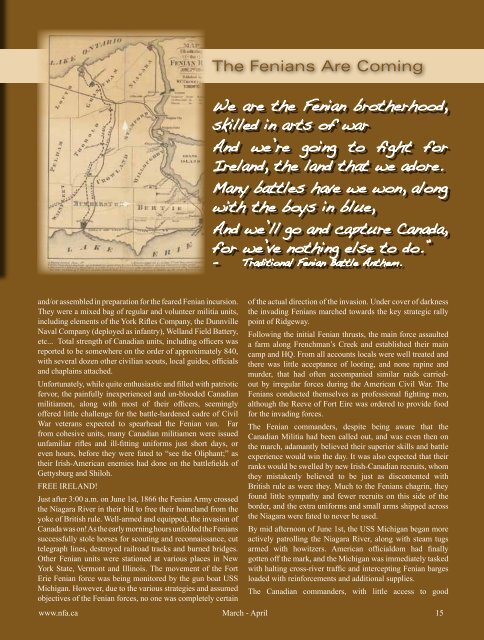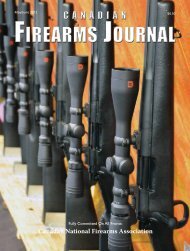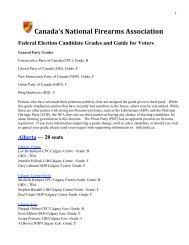download - the National Firearms Association
download - the National Firearms Association
download - the National Firearms Association
You also want an ePaper? Increase the reach of your titles
YUMPU automatically turns print PDFs into web optimized ePapers that Google loves.
The Fenians Are Coming<br />
We are <strong>the</strong> Fenian bro<strong>the</strong>rhood,<br />
skilled in arts of war<br />
And we’re going to fight for<br />
Ireland, <strong>the</strong> land that we adore.<br />
Many battles have we won, along<br />
with <strong>the</strong> boys in blue,<br />
And we’ll go and capture Canada,<br />
for we’ve nothing else to do.”<br />
- Traditional Fenian Battle An<strong>the</strong>m.<br />
and/or assembled in preparation for <strong>the</strong> feared Fenian incursion.<br />
They were a mixed bag of regular and volunteer militia units,<br />
including elements of <strong>the</strong> York Rifles Company, <strong>the</strong> Dunnville<br />
Naval Company (deployed as infantry), Welland Field Battery,<br />
etc... Total strength of Canadian units, including officers was<br />
reported to be somewhere on <strong>the</strong> order of approximately 840,<br />
with several dozen o<strong>the</strong>r civilian scouts, local guides, officials<br />
and chaplains attached.<br />
Unfortunately, while quite enthusiastic and filled with patriotic<br />
fervor, <strong>the</strong> painfully inexperienced and un-blooded Canadian<br />
militiamen, along with most of <strong>the</strong>ir officers, seemingly<br />
offered little challenge for <strong>the</strong> battle-hardened cadre of Civil<br />
War veterans expected to spearhead <strong>the</strong> Fenian van. Far<br />
from cohesive units, many Canadian militiamen were issued<br />
unfamiliar rifles and ill-fitting uniforms just short days, or<br />
even hours, before <strong>the</strong>y were fated to “see <strong>the</strong> Oliphant;” as<br />
<strong>the</strong>ir Irish-American enemies had done on <strong>the</strong> battlefields of<br />
Gettysburg and Shiloh.<br />
FREE IRELAND!<br />
Just after 3:00 a.m. on June 1st, 1866 <strong>the</strong> Fenian Army crossed<br />
<strong>the</strong> Niagara River in <strong>the</strong>ir bid to free <strong>the</strong>ir homeland from <strong>the</strong><br />
yoke of British rule. Well-armed and equipped, <strong>the</strong> invasion of<br />
Canada was on! As <strong>the</strong> early morning hours unfolded <strong>the</strong> Fenians<br />
successfully stole horses for scouting and reconnaissance, cut<br />
telegraph lines, destroyed railroad tracks and burned bridges.<br />
O<strong>the</strong>r Fenian units were stationed at various places in New<br />
York State, Vermont and Illinois. The movement of <strong>the</strong> Fort<br />
Erie Fenian force was being monitored by <strong>the</strong> gun boat USS<br />
Michigan. However, due to <strong>the</strong> various strategies and assumed<br />
objectives of <strong>the</strong> Fenian forces, no one was completely certain<br />
of <strong>the</strong> actual direction of <strong>the</strong> invasion. Under cover of darkness<br />
<strong>the</strong> invading Fenians marched towards <strong>the</strong> key strategic rally<br />
point of Ridgeway.<br />
Following <strong>the</strong> initial Fenian thrusts, <strong>the</strong> main force assaulted<br />
a farm along Frenchman’s Creek and established <strong>the</strong>ir main<br />
camp and HQ. From all accounts locals were well treated and<br />
<strong>the</strong>re was little acceptance of looting, and none rapine and<br />
murder, that had often accompanied similar raids carriedout<br />
by irregular forces during <strong>the</strong> American Civil War. The<br />
Fenians conducted <strong>the</strong>mselves as professional fighting men,<br />
although <strong>the</strong> Reeve of Fort Eire was ordered to provide food<br />
for <strong>the</strong> invading forces.<br />
The Fenian commanders, despite being aware that <strong>the</strong><br />
Canadian Militia had been called out, and was even <strong>the</strong>n on<br />
<strong>the</strong> march, adamantly believed <strong>the</strong>ir superior skills and battle<br />
experience would win <strong>the</strong> day. It was also expected that <strong>the</strong>ir<br />
ranks would be swelled by new Irish-Canadian recruits, whom<br />
<strong>the</strong>y mistakenly believed to be just as discontented with<br />
British rule as were <strong>the</strong>y. Much to <strong>the</strong> Fenians chagrin, <strong>the</strong>y<br />
found little sympathy and fewer recruits on this side of <strong>the</strong><br />
border, and <strong>the</strong> extra uniforms and small arms shipped across<br />
<strong>the</strong> Niagara were fated to never be used.<br />
By mid afternoon of June 1st, <strong>the</strong> USS Michigan began more<br />
actively patrolling <strong>the</strong> Niagara River, along with steam tugs<br />
armed with howitzers. American officialdom had finally<br />
gotten off <strong>the</strong> mark, and <strong>the</strong> Michigan was immediately tasked<br />
with halting cross-river traffic and intercepting Fenian barges<br />
loaded with reinforcements and additional supplies.<br />
The Canadian commanders, with little access to good<br />
www.nfa.ca March - April 15















